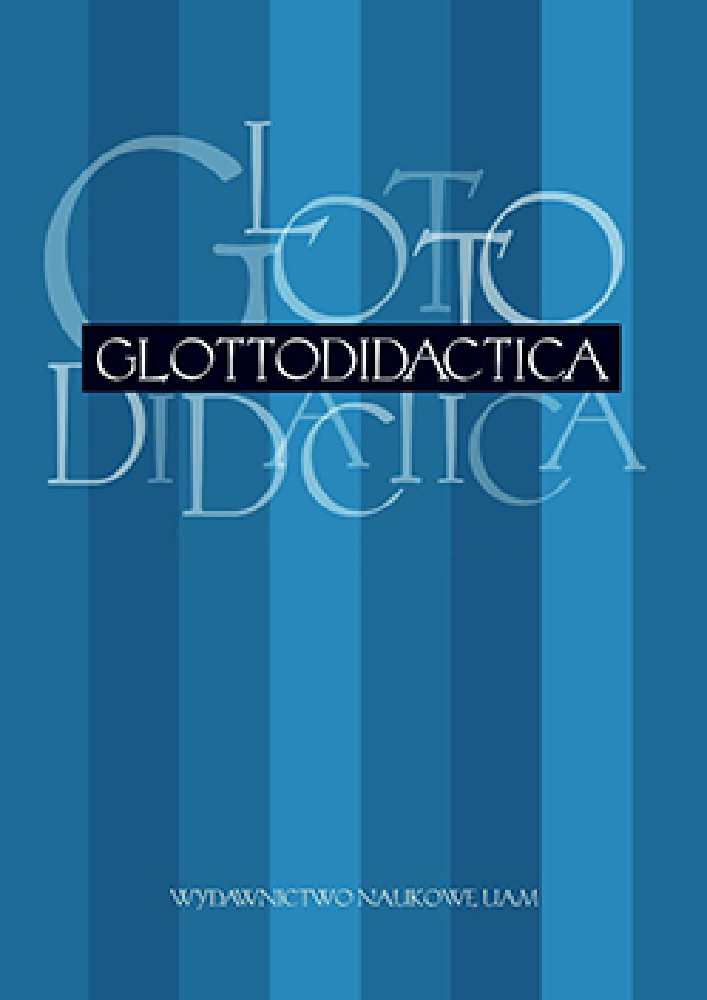Abstract
Pronunciation is an often-neglected aspect of language instruction. Teachers usually
place the blame on lack of time and resources, as well as curricular restrictions. However, in recent years, we have witnessed a proliferation of various tools that can be used to render work on different aspects of pronunciation much more interesting. In the present paper, we will focus on one particular technique: video dubbing. By examining the answers provided by the participants of a dubbing project conducted by the author of the present study, we will try to reflect on the potential advantages of such activities, and determine whether they are considered stimulating and effective by language learners.
Literaturhinweise
Baran-Łucarz, M. (2006). Prosto w oczy – fonetyka jako ‘Michałek’ na studiach filologicznych? In: W. Sobkowiak / E. Waniek-Klimczak (eds.). Dydaktyka fonetyki języka obcego w Polsce. Konin: Wydawnictwo PWSZ, 7–17.
Burston, J. (2005). Video dubbing projects in the foreign language curriculum. CALICO Journal, 23 (1), 79–92.
Charliac, L. / Motron, A.C. (2006). Phonétique progressive du français. Niveau avancé. Paris : CLE International.
Chiu, Y. (2012). Can film dubbing projects facilitate EFL learners’ acquisition of English pronunciation? British Journal of Educational Technology, 43 (1), pp. 24–27.
Danan, M. (2010). Dubbing projects for the language learner: a framework for integrating audiovisual translation into task-based instruction. Computer Assisted Language Learning, 23 (5), 441–456.
Gilet, G. (2012). Doublage d’un extrait de Volver d’Almodóvar et modification du scénario. Recherche et pratiques pédagogiques en langues de spécialité, 31 (2), 151–159.
Gajewska, E. (2011). Techniki nauczania języka obcego. Tarnów: PWSZ w Tarnowie.
Golshan, N.S. / Nosratzadeh, H. (2015). The impact of video dubbing, voice recording and shadowing tasks on Iranian EFL learners’ command of pronunciation. International Journal of Language and Applied Linguistics, 1, pp. 7–16.
Goodman, S. (2003). Teaching Youth Media: A Critical Guide to Literacy, Video Production, & Social Change. Nowy Jork: Teachers College Press.
Górska, W. (2009). Narzędzia web 2.0 w codziennej pracy nauczyciela języków obcych. Neofilolog, 33, pp. 197–204.
Hermeline, L. (2001). Enseigner la phonétique : oui, mais comment? Le français dans le monde, 318, pp. 27–28.
Hincks, R. / Edlund, J. (2009). Promoting increased pitch variation in oral presentation with transient visual feedback. Language Learning and Technology, 13 (3), pp. 32–50.
Huang, H.D. / Hung, S.A. (2015). Effects of a video-dubbing task: perspectives of EFL learners. In: J. Colpaert / A. Aerts / M. Oberhofer / M. Gutiérrez-Colón Plana (eds.). Proceedings of the seventeenth International CALL Research Conference, Tarragona, Universitat Rovira i Virgili,
—8 July 2015. Antwerp: University Press Antwerp. pp. 286–288.
Kondo, I. (2002). Video and learner enthusiasm: Stimulating personal interest as the first step towards autonomy In: A.S. Mackenzie / T. Newfield (eds.). Proceedings of the JALT CUE and TEVAL mini-conferences. Kyoto, Japan, Tokyo: JALT, pp. 83–86.
Kotuła, K. (2014). Les pratiques innovatrices en classe de langues. L’édition et la production des films dans l’enseignement de FLE. Studia Romanica Posnaniensia, 41 (3), pp. 47–61.
Luo, B. (2014). Evaluating a computer-assisted pronunciation training (CAPT) technique for efficient classroom instruction. Computer Assisted Language Learning, 29 (3), pp. 451–476.
Olson, D.J. (2014). Benefits of visual feedback on segmental production in the L2 classroom. Language Learning & Technology, 18 (3), pp. 173–192.
Parizet, M.L. (2008). Phonétique et Cadre Commun: propositions pour un cours de FLE. Synergies Espagne 1, pp. 113–122.
Qian, X. / Meng H. / Soong, F. (2016). Two-pass framework of mispronunciation detection & diagnosis for computer-aided pronunciation training. IEEE/ACM Transactions on Audio, Speech, and Language Processing, 24 (6), pp. 1020–1028.
Richards, J.C. / Renandya, W.A. (2002). Methodology in language teaching: An anthology of current practice. Cambridge: Cambridge University Press.
Rojczyk, A. (2011). Wykorzystanie programu do analizy mowy w nauce wymowy języka obcego. Nagłosowy kontrast dźwięczności w języku angielskim. In : M. Pawlak / B. Wolski (eds.). Wykorzystanie nowoczesnych technologii w dydaktyce języków obcych. Konin: Wydawnictwo
PWSZ, pp. 65–74.
Wachob, P. (2010). Using videos of students in the classroom to enhance learner autonomy. Teaching English with Technology, 11, pp. 18–28.
Wakefield, J.C. (2014). Dubbing as a method for language practice and learning. In: C. DeCoursey (ed.). Language Arts in Asia 2: English and Chinese through literature, drama and popular culture Newcastle upon Tyne: Cambridge Scholars Publishing, pp. 160–166.
Lizenz
Authors
Authors of texts accepted for publication in Glottodidactica are required to complete, sign and return to the editor's office the Agreement for granting a royalty-free license to works with a commitment to grant a CC sub-license.
Under the agreement, the authors of texts published in Glottodidactica grant the Adam Mickiewicz University in Poznań a non-exclusive, royalty-free license and authorize the use of Attribution-NoDerivatives 4.0 International (CC BY-ND 4.0) Creative Commons sub-license.
The authors retain the right to continue the free disposal of the work.
Users
Interested Internet users are entitled to use works published in Glottodidactica since 2016, under the following conditions:
- attribution - obligation to provide, together with the distributed work, information about the authorship, title, source (link to the original work, DOI) and the license itself.
- no derivatives - the work must be preserved in its original form, without the author's consent it is not possible to distribute the modified work, such as translations, publications, etc.
Copyrights are reserved for all texts published before 2016.
Miscellaneous
Adam Mickiewicz University in Poznań retains the right to magazines as a whole (layout, graphic form, title, cover design, logo etc.).





